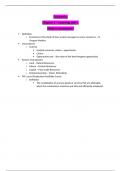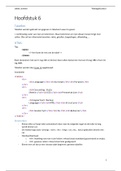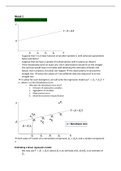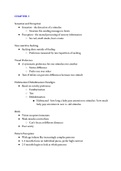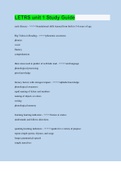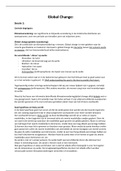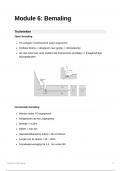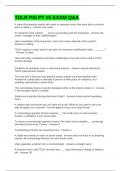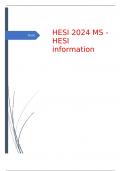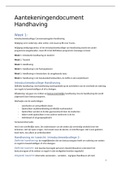Chapter 1 – Learning unit 1
What is economics?
Definition
o Economics is the study of how society manages its scarce resources. ~ N
Gregory Mankiw
Cornerstones
o Scarcity
Limited resources, choice = opportunity
Choice
Opportunity cost – the value of the best-foregone opportunity
Factors of production
o Land – Natural Resources
o Labour – Human Resources
o Capital – Man-made Resources
o Entrepreneurship – Vision, Risk-taking
PPC curve (Production Possibility Curve)
o Definition
The combination of any two goods or services that are attainable
when the community’s resources are fully and efficiently employed.
,5000 A
B
Quantity of cakes
F
C
E
D
300
Quantity of TV’S
Mark on PPC = efficient
Inside PPC = inefficient/unemployment, not using all resources
Inside or on PPC = attainable
Outside = unattainable
Opportunity cost = e.g., 5000 cakes sacrifice 300 TV’s, E-C = 0 opportunity cost
A-E not F can represent choice.
PPC curve represents the scarcity = shows limitations
Swivel = one axis moves
i.e., resources increase or
Shift = both axes move
decrease
, Economics is a Social Science
Science that involves a systematic attempt to discover regular patterns of behaviour.
Patterns
o explain what is happening (the level of the petrol price and why)
o Predict what might happen (future prices and impact on the economy)
o So that decision makers can choose the right economic policies (in respect of
the petrol prices)
Social science – involves the study of behaviour in human beings, both individually
and as groups.
Difference between natural sciences and social sciences
o What and how things are studied
o Is in the nature of their generalisation (Law of demand: outcome that if price
falls demand for item increases)
Law of demand: Conditional on all other things remaining the same. In other words
ceteris paribus
Economics is an empirical science.
Micro- and macroeconomics
Microeconomics – focuses on individual parts of the economy.
o Households (what to do, what to buy)
o Firms (what to produce, how to produce them, what prices to charge, etc)
o Includes the study of demand, supply and prices of individual goods and
services like petrol, haircuts and medical services.
Macroeconomics – concerned with the economy as a whole
o Emphasis is on Total production, income and expenditure, economic growth,
aggregate unemployment, the general price level, inflation and the balance of
payments.
Microeconomics Macroeconomics
The price of a single product The consumer price index
Charges in the price of a product, like Inflation (i.e. the increase in the general
tomatoes level of prices in the country)
The production of maze The total output of all goods and
services in the economy
The decisions of individual consumers The combined outcome of the decisions
of all consumers in the country
The decision of individual firms or The combined decisions of all firms in
business the country

